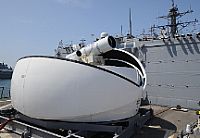Back in April 2013 we took a look at the possibility that the U.S. may control space-based laser weapons (link here). Now we see that the U.S. Navy has just released information about a new Ship-based laser weapon – Called “laWS” (laser weapon system). Here’s the description on the Department of Navy website (link).
(excerpt)
“From Office of Naval Research ARLINGTON, Va. (NNS) — Navy engineers are making final adjustments to a laser weapon prototype that will be the first of its kind to deploy aboard a ship late this summer.
The prototype, an improved version of the Laser Weapon System (LaWS), will be installed on USS Ponce for at-sea testing in the Persian Gulf, fulfilling plans announced by Chief of Naval Operations Adm. Jonathan Greenert at the 2013 Sea-Air-Space Expo.
“This is a revolutionary capability,” said Chief of Naval Research Rear Adm. Matthew Klunder. “It’s absolutely critical that we get this out to sea with our Sailors for these trials, because this very affordable technology is going to change the way we fight and save lives.”
Navy leaders have made directed-energy weapons a top priority to counter what they call asymmetric threats, including unmanned and light aircraft and small attack boats that could be used to deny U.S. forces access to certain areas. High-energy lasers offer an affordable and safe way to target these threats at the speed of light with extreme precision and an unlimited magazine, experts say.
“Our nation’s adversaries are pursuing a variety of ways to try and restrict our freedom to operate,” Klunder said. “Spending about $1 per shot of a directed-energy source that never runs out gives us an alternative to firing costly munitions at inexpensive threats.”
Klunder leads the Office of Naval Research (ONR), which has worked with the Naval Sea Systems Command, Naval Research Laboratory, Naval Surface Warfare Center Dahlgren Division and others to make powerful directed-energy weapons a reality.
The Navy already has demonstrated the effectiveness of lasers in a variety of maritime settings. In a 2011 demonstration, a laser was used to defeat multiple small boat threats from a destroyer. In 2012, LaWS downed several unmanned aircraft in tests.
Over the past several months, working under the ONR Quick Reaction Capability program, a team of Navy engineers and scientists have upgraded LaWS, and proved that targets tracked with a Phalanx Close-In Weapon can be easily handed over to the laser’s targeting and tracking system. The result is a weapon system with a single laser weapon control console, manned by a surface warfare weapons officer aboard USS Ponce who can operate all functions of the laser-and if commanded, fire the laser weapon.
Using a video game-like controller, that sailor will be able to manage the laser’s power to accomplish a range of effects against a threat, from disabling to complete destruction.”.(More at Link)
———————————-
So this technology must have been in existence for quite a while, possibly on a secret level, but long rumored to have been field tested in combat. For all we know, this may also explain bizzarre happenings such as precision organ removal in cattle mutilations.
Now it seems entirely possible that some of our satellites up there may also be equipped with lasers.
From last years Dojo Rat article “Are Space-Based Laser Platforms A Reality?”:
Space Based Laser [SBL]The potential to intercept and destroy a missile over enemy territory soon after launch, rather than over friendly territory, makes the development of a boost phase intercept (BPI) capability very desirable. In concert with ground based theater missile defense (TMD) systems already under development, the U.S. continues to investigate BPI concepts for BMD systems.
The SBL program could develop the technology to provide the U.S. with an advanced BMD system for both theater and national missile defense. BMDO believes that an SBL system has the potential to make other contributions to U.S. security and world security as a whole, such as inducing potential aggressors to abandon ballistic missile programs by rendering them useless. Failing that, BMDO believes that the creation of such a universal defense system would provide the impetus for other nations to expand their security agreements with the United States, bringing them under a U. S. sponsored missile defense umbrella.
An SBL platform would achieve missile interception by focusing and maintaining a high powered laser on a target until it achieves catastrophic destruction. Energy for the sustained laser burst is generated by the chemical reaction of the hydrogen fluoride (HF) molecule. The HF molecules are created in an excited state from which the subsequent optical energy is drawn by an optical resonator surrounding the gain generator.
Lasers have been studied for their usefulness in air defense since 1973, when the Mid Infrared Advanced Chemical Laser (MIRACL) was first tested against tactical missiles and drone aircraft. Work on such systems continued through the 1980s, with the Airborne Laser Laboratory, which completed the first test laser intercepts above the earth. Initial work on laser based defense systems was overseen by the Defense Advanced Research Projects Agency (DARPA), but transferred to the newly created Strategic Defense Initiative Organization (SDIO) in 1984. Work continues today under the auspices of the BMDO, the successor to the SDIO.
(snip)
Current SBL planning is based on a 20 satellite constellation, operating at a 40� inclination, intended to provide the optimum TMD threat negation capability. At this degree of deployment, kill times per missile will range from 1 to 10 seconds, depending on the range from the missile. Retargeting times are calculated at as low as 0.5 seconds for new targets requiring small angle changes. It is estimated that a constellation consisting of only 12 satellites can negate 94% of all missile threats in most theater threat scenarios. Thus a system consisting of 20 satellites is expected by BMDO to provide nearly full threat negation.”
——————————————
For all you wonky science geeks out there, check out this link which appears to show patent information and descriptions for a Boeing-built space-based laser weapon (link).


